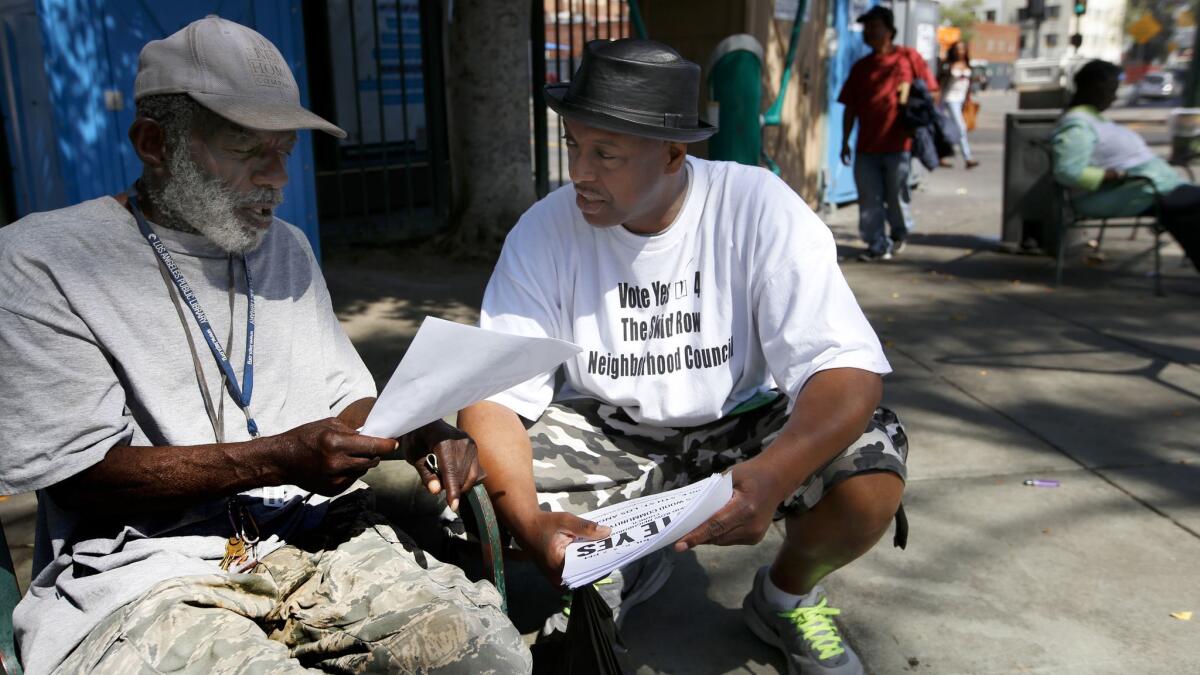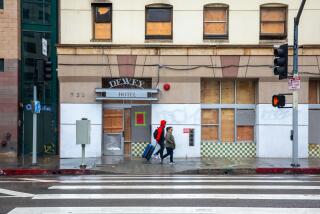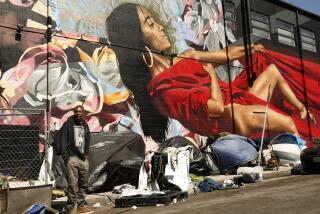With L.A.’s skid row at a tipping point, a divisive vote on local representation

General Jeff Page
Voters in Los Angeles city and county have loudly asserted their desire to conquer homelessness in recent months, approving two tax measures that will provide billions of dollars for housing and services over the next decade.
But the money can’t arrive quickly enough for skid row, which has reached a critical point as relentless development presses in on the 50-block neighborhood and living conditions grow more dire for thousands of its homeless residents.
Against this backdrop, another type of election is concluding Thursday — one limited to people with ties to downtown — that will determine whether skid row gets its own neighborhood council and, potentially, a stronger voice in shaping its future.
The measure, if approved, would create the Skid Row Neighborhood Council, allowing the epicenter of Los Angeles homelessness — bounded by Main, Alameda, 3rd and 7th streets — to break away from two larger councils.
Most of skid row is now represented by the Downtown Los Angeles Neighborhood Council, whose board is dominated by loft owners, market-rate apartment renters and business interests.
Measure organizers say skid row’s 10,000 residents have been sadly neglected as the rest of downtown has boomed. They are calling for showers, bathroom access, 24-hour cleanups, family housing, parks, tree-plantings and other amenities for those who live in the neighborhood’s streets, tenements and refurbished welfare hotels.
Opponents counter that skid row should be better integrated into the rest of downtown. The central city is stronger if it speaks with one voice, says this faction, which backs housing aimed at working people with moderate incomes, retail projects and more policing to lift skid row out of its squalor.

The council proposal comes as residential development for people who can pay market rates is pushing into skid row.
The Topaz apartment complex, currently under construction, will open onto both Main and Los Angeles streets. While Main has undergone significant gentrification, Los Angeles — just one block over — has seen little to none. Even deeper into skid row, a live-work loft project is proposed at the old Catalina swimwear headquarters on San Pedro Street across from the Downtown Women’s Center, which serves homeless clients.
At the same time, police and social service providers say the level of misery is unprecedented for skid row, with as many as 2,000 people squeezed into increasingly confined and violent tent encampments.
“It’s like a slow landslide; it just keeps going down,” said Mel Tillekeratne, whose volunteer group, Monday Night Mission, feeds skid row residents every weeknight.
“It’s never been worse,” said Andy Bales of Union Rescue Mission, adding that his shelter is housing 55% more people this year than last.
General Jeff Page, the proposed council’s lead organizer, said skid row residents can do better on their own.
“These are homeless people trying to help themselves,” Page said. “They say we want to put more tents up on streets. No, we want housing.”
But opponents say the new council would do little to tamp down the area’s drugs and disorder.
Scott Gray, director of operations at Capital Foresight, a downtown developer, predicted the council would drive the area backward. “The tents are more likely to expand,” he said.
The skid row election is the first test of a new ordinance making it possible for neighborhood councils to be subdivided. Although some analysts dismiss neighborhood councils as purely advisory bodies, they have flashed muscle at City Hall.

The new council would be carved out of the areas currently represented by the Downtown Los Angeles and the Historic Cultural neighborhood councils. Its fate will be decided by people with ties to those broader swaths of downtown — workers, business owners, employers and members of volunteer groups, as well as residents.
The proposal has proved divisive, with online descriptions of skid row as nothing but a drug market, and counter-accusations of racism and economic marginalization.
Some residents of Main Street lofts vehemently oppose being labeled part of skid row. But some Little Tokyo and Arts District residents appear to favor a skid row council, said Yuval Bar-Zemer, who developed the Arts District’s Biscuit Company and Toy Factory lofts.
“It’s pretty amazing to see a grass-roots group from this area get support and say, ‘We have a voice we want to articulate,’” said Bar-Zemer, who sits on the Historic Cultural Neighborhood Council board.
Dr. Josh Albrektson, a radiologist and downtown council board member, said the new council’s proposed board seats leave out business owners. He also argued that homeless services should be spread around the city.
“Skid row is a place every drug dealer goes to because it has the most addicts in Los Angeles,” Albrektson said. “If we spread the services, it wouldn’t be all in one place.”
Skid row council supporters call the dispersal argument code for getting rid of homeless people.
Both sides say they back mixed residential and business development and help for homeless people. The question is what mix, where and for whom?
Nonprofit developers have proposed hundreds of new homeless apartments on skid row.
Those include the Weingart Center Assn.’s plan for an 18-story, 278-unit tower on Crocker Street. Most of the units would be for chronically homeless, disabled people, while 56 one-bedroom apartments would be for low-income people who don’t qualify for supportive services.
By contrast, a 236-unit apartment project planned to replace Triangle Plaza shopping center on Central Avenue would primarily serve market-rate renters. Eleven units would be set aside for “very low-income” households.
Downtown business groups pushed the City Council for a last-minute decision allowing online voting and early pop-up polling stations. That decision could favor existing councils with access to membership lists for email blasts.
But homeless people without identification will be allowed to “self-affirm” their status, while online voters have to register ID documents.
Page hopes to draw support from church and other groups that volunteer on skid row. An early L.A. hip-hop pioneer, Page lined up YouTube testimonials from rap luminaries including DJ Battlecat and Mellow Man Ace to promote the council cause.
“It’s very important that we have a voice for the homeless,” Lonzo Williams of World Class Wreckin’ Cru — who was portrayed in the 2015 hip-hop film “Straight Outta Compton” — told viewers.
The election might not be the last word on a skid row council. At a public hearing, former City Atty. Rocky Delgadillo, representing a group called United Downtown L.A., outlined elements of a possible legal challenge to the skid row council proposal.
Twitter: @geholland
More to Read
Start your day right
Sign up for Essential California for news, features and recommendations from the L.A. Times and beyond in your inbox six days a week.
You may occasionally receive promotional content from the Los Angeles Times.





